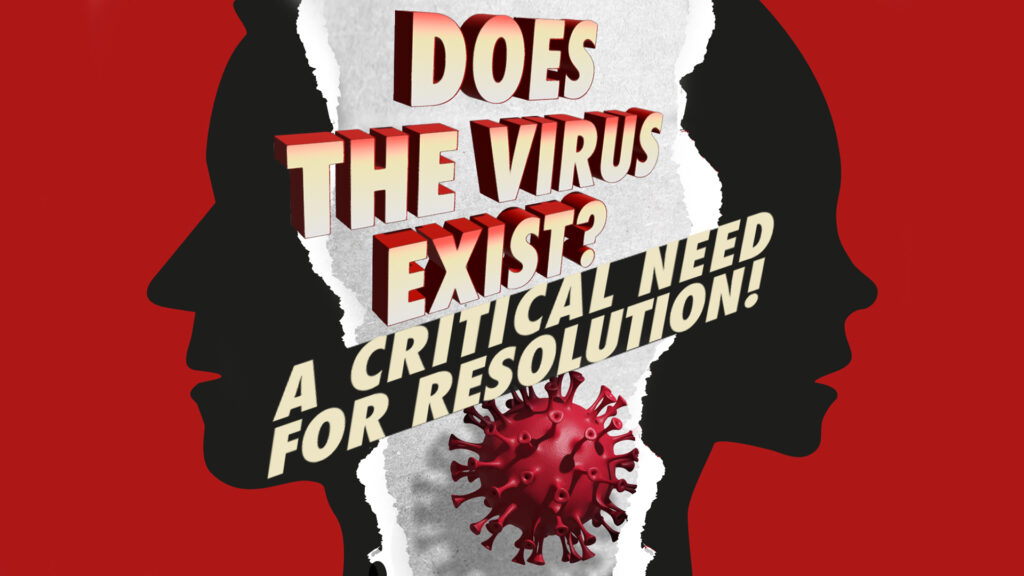How polarisation of views on SARS-CoV-2 and ‘pathogenic viruses’ will divide and conquer the health freedom movement

By Rob Verkerk PhD
Founder, executive & scientific director, Alliance for Natural Health International
Co-chair, Health & Humanities Committee, World Council for Health
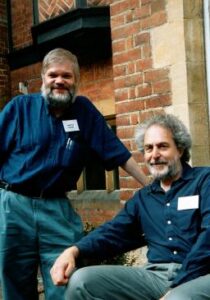
The airwaves of alt media are once again bristling with strings of activity over whether or not COVID-19 is a manipulated hoax that doesn’t even involve an infectious microbial agent in the form of SARS-CoV-2.
This one’s not going away either – at least until there’s some reconciliation – such is the passion each side has for its arguments. What makes this latest polarisation unique is that it is the first that could do real harm to the truth and health freedom movement. A movement that’s so far been more or less united in calling out manipulated science and defects in global policy on COVID-19, whether that’s unjustified lockdowns or masks, misleading PCR or mortality data, or creeping totalitarianism.
If you haven’t yet had a dive into the rabbit hole of this latest division of views, expect it to be more of a warren than a hole. It pertains not just to the field of virology, but draws on a host of interfacing disciplines, from experimental science, to molecular biology, genomics, computational biology, bioinformatics, evolutionary biology, ecology and even anthropology.
The players
Among the currently vocal protagonists of the ‘no virus exists’ side of the debate is virologist Stefan Lanka PhD (Germany), four medically trained doctors, Dr Tom Cowan (USA), Dr Sam Bailey (NZ), her husband, Dr Mark Bailey (NZ), and Dr Andrew Kaufman (USA). Health and exercise scientist, Mike Stone (USA), has done a comprehensive job coalescing most of the key arguments into a single website, viroLIEgy.com. These six are among the signatories, who include ex-Pfizer vice president Dr Mike Yeadon, formerly vice president & chief scientific officer of Allergy & Respiratory at Pfizer Global R&D, of the Settling the Virus Debate challenge put forward by Drs Cowan et al in July 2022.
I’ll nail my cards to the tree now and predict that this Settling the Virus Debate challenge will likely lead to a dead end without any resolution because it won’t get the participation required. It will be seen as unnecessary or irrelevant. Another case for calling in Doug Altman and Martin Bland’s profound logic: the absence of evidence is not evidence of absence. Perhaps a tangential analogy to help explain my concerns? You’ve been doing your weekly shopping at your local grocery store for years and just as you’re about to enter, a stranger taps you on the shoulder and challenges you to now do your shopping while standing on your head. You would likely think the challenge was odd, impossible, irrelevant or pointless. More to the point, you’d probably be unlikely to even try.
On the other side of the house…is pretty much everyone else. Those who have voiced opposing views to the ‘no virus exists’ protagonists, but from within the health freedom movement, include Steve Kirsch (here) and Jeremy Hammond (here). For information, neither are virologists, scientists, medical doctors or health practitioners.
Leading doctors who continue to challenge key aspects of the mainstream narrative on COVID-19, who have also countered the Cowan, Bailey, Kaufman positions, include Drs Bob Malone, Peter McCullough and Ryan Cole. They uphold a view shared by many that viruses, including SARS-CoV-2, do actually exist, that they require a suitable host cell to be able to infect and replicate, and they can in certain people under certain conditions cause disease.
If you want to dive into the scientific arguments lining the virus denial rabbit burrow system, easy access points are Dr Tom Cowan’s Virus Challenge, Drs Sam and Mark Bailey’s website, and Mike Stone’s website viroLIEgy.
Let’s not forget there are actually a myriad of different positions, not just two. One more to contemplate, one that most people on the planet likely subscribe to. It’s that viruses, as obligate intracellular parasites that need to hijack their host’s replication machinery, are inherently pathogenic and therefore are bad guys that we’d all be better to live without. That’s why trying to hide from them, kill them, or get your body to wipe them out by using vaccines or antiviral medications makes so much sense. That is, if you accept ‘viruses are the real enemy’ position. More on that later.
Unwrapping the sticking points
I’m not a virologist, but I have three science degrees (BSc, MSc, PhD), I’ve worked as a postdoc researcher for 7 years at a major university (Imperial College London, before the Gates funding take-over) in the field of multitrophic interactions, and have spent 40 years using science as a tool to help understand the incredibly complex workings of nature. I’ve worked in academia, as a consultant, as an educator and as a natural health activist, the last 20 years with the non-profit I set up back in 2002, the Alliance for Natural Health.
I’ve written this article not in some belief it might help resolve this complex debate, but rather to offer some of my own insights about why this schism has arisen, and why it’s critical we work through it if we’re not to see the freedom movement against the mainstream narrative divided and conquered. I also think it’s so important that this debate — in the manner of all proper scientific discourse (of which we’ve seen very little over these last few years) — is conducted respectfully by focusing, debating and pondering the issues at hand, not by attacking the messengers.
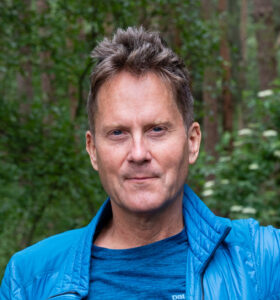
What is meant by ‘does the virus exist’?
When people challenge the notion as to whether a virus is involved with COVID-19, their views may still differ in some fundamental respects. Some are entirely comfortable with the notion that viruses are non-living entities consisting of a central core of either DNA or RNA, nearly always surrounded by a protein coat. Seen in this way, viruses don’t do a bunch of things living organisms do. They don’t produce waste products, they don’t grow or develop, they lack any kind of energy metabolism, they don’t tend to respond to stimuli and they can’t reproduce (replicate) independently. They must rely on a host so must invade the cells of living things and hijack the host cells’ replication machinery to make new copies of themselves. They can move genetic material between organisms and it is widely upheld that some 8% of the human genome is derived from ancestral retroviruses that has over eons been incorporated into our DNA, our genetic blueprint or ‘book of life’. This general view, as it happens, is shared by the vast majority within the scientific community.
It’s worth recognising that viruses are in some ways more digital than living. In fact, they’re not living at all. Everything they do relies on a digital code made up of the four ‘letters’ or bases of DNA or RNA, comprised of sequences of four nitrogenous base pairs, namely adenine (A), cytosine (C), thymine (T) for DNA or uracil (U) in place of T for RNA, and guanine (G).
"It’s worth recognising that viruses are in some ways more digital than living. In fact, they’re not living at all."
John Doe
This is why digital technology that humans have developed, that relies on computer technology, genomics and bioinformatics, such as Next Generation Sequencing (more on that later), is able to understand the language of viruses, and is helping unravel so many of the mysteries linked to virus-host interactions.
Even if you agree that viruses, as non-living entities, aren’t just a fake construct masterminded by a bunch of greedy humans, you may not agree that viruses are the causative agents responsible for diseases that have become regarded as “viral diseases”, such as smallpox, chickenpox, measles, polio, dengue, flu, HIV, hepatitis B or, for that matter, COVID-19.
In short, you might feel that Pasteur’s Germ Theory of Disease is misplaced or even entirely false, and has been misused as a vehicle to pedal vast amounts of vaccines and drugs to an unsuspecting public.
Among the array of differing views, perceptions and beliefs out there, there are two particular viewpoints that are not shared by the vast majority of us scientists out there.
The first is the notion that no virus of any sort has ever been proven to exist. The second, that doesn’t require this first notion to be accepted, is that the virus that was given the name SARS-CoV-2 by the World Health Organization (WHO), and has been associated with the COVID-19 pandemic formerly announced by the WHO in March 2020, has never been proven to exist.
The view that SARS-CoV-2 is entirely fictitious might be seen as enticing because it immediately reveals every aspect of the mainstream narrative to be a hoax. It also conveniently makes redundant the key corrective strategies offered by the mainstream, namely ‘genetic vaccines’ and antivirals.
"The view that SARS-CoV-2 is entirely fictitious might be seen as enticing because it immediately reveals every aspect of the mainstream narrative to be a hoax. It also conveniently makes redundant the key corrective strategies offered by the mainstream, namely 'genetic vaccines' and antivirals."
John Doe
Paraphrasing the ‘No Virus Exists’ debate
Don’t shoot me, but I will do my best to try to paraphrase where we currently are with the so-called ‘virus debate’.
Virus deniers argue that virology doesn’t follow the scientific method that includes critical steps such as observation, development of hypotheses, and replicable, controlled experimentation to test and validate the hypotheses. Virologists will argue that they are dealing with a particularly challenging interaction because viruses are not organisms, they are simply bits of genetic information in the form of single or double-stranded RNA or DNA that is usually protected by a protein coat, and that viruses can only multiply if they dodge the host’s immune system and find their way into a given host cell with suitable receptors, and then successfully take over its replication machinery. This means virologists have had to develop unique methods specific to virology and individual viruses. It also means that recent developments in whole genome sequencing technology have triggered a massive acceleration of the field of virology (including vaccine and antiviral development) because it allows the active part of a virus to be understood according to the 4 letter genetic language of nature.
Among the key tenets upheld by virus denialists is the idea that the virus hasn’t been isolated and purified, and it hasn’t been observed to be infectious or capable of causing disease (i.e. be pathogenic). They say the often non-human (such as green monkey/Vero) cell cultures on which viruses are supposedly grown and concentrated are contaminated with antibiotics, heavy metals and other nasties. Virologists claim these are necessary to stop mycoplasmas, bacteria and other microbes contaminating samples and they don’t damage the non-living RNA or DNA nucleic acids that represent the ‘guts’ of any virus.
When particles that are claimed to look like previously described viruses are observed using, for example, electron microscopy, virus deniers say this is no proof these are viruses because the particles from these cultures have not been shown to be infective and cause the particular disease in question. They say these particles are likely just artefacts or exosomes – nano-sized extra-cellular signalling particles that contain nucleic acids that are produced in response to cellular stress and, specifically here, the abuses of the cell culture.
Others might be persuaded that the detailed scanning electron microscopy carried out by, say, the French group publishing in Frontiers in Microbiology over two years ago more than adequately shows the infectious cycle of SARS-CoV-2 – and not exosomes. Virologists and pathologists will argue they have limited options for culturing samples taken from humans; they can only use very few types of cell culture because all viruses have very limited hosts and can only infect them if the host cell has receptors specific to the particular virus, ACE2 receptors being proposed as the key receptors for SARS-CoV-2.
When researchers find a culturing system that works this then becomes the accepted system that others use, helping work in different labs to be comparable because the culture system (a controllable variable) is the same.
Virologists who are researching what they consider infectious or pathogenic (disease-causing) viruses claim that the cytopathic effects shown in cell cultures are caused by the virus hijacking the replication machinery of the cells in cell culture and provide evidence of infection.
Virus deniers go on to say the genetic sequences that are ‘read’ and computed from this cell culture soup provide only indirect, rather than direct, evidence of the existence of a virus because the sequence is now computer generated and exists in silico, not in the real world.
"Virus deniers go on to say the genetic sequences that are ‘read’ and computed from this cell culture soup provide only indirect, rather than direct, evidence of the existence of a virus because the sequence is now computer generated and exists in silico, not in the real world. "
John Doe
These and more arguments were recently clearly voiced by Mike Stone, Eric Coppolino and Mark Bailey on the Dolores Cahill Show on TNT Radio.
Further momentum has been given to these views following Christine Massey’s Freedom of Information (FoI) requests of 90 different health and scientific institutions around the world, that has apparently failed to show a single record of isolation and purification, having “been performed by anyone, anywhere, ever”.
Cutting to the chase
Out of all the noise and hubris, some of it twisted and amplified by lay followers whose understanding of science prevents them from critically appraising either side of the argument in a meaningful way, are two foundational claims by the virus denier sub-movement:
- The whole SARS-CoV-2 virus genome taken from an infected patient replete with its 30,000 base pairs has never been isolated and sequenced and therefore cannot be proven to exist
- This so-called ‘virus’ has not been shown to cause COVID-19 disease by satisfying Koch’s postulates, a methodology proposed originally by the German physician Robert Koch and microbiologist Friedrich Loeffler in 1884. The postulates were based on concepts developed by Koch’s former professor, Jakob Henle and others, such as Agostino Bassi, who are both credited with co-founding the theory that microorganisms are the cause of infectious diseases. The methodology built on the then emerging germ theory of disease as proposed by the French chemist and microbiologist Louis Pasteur and the English surgeon, Joseph Lister. The four criteria, comprising what are sometimes also referred to as the Koch-Henle (or Henle-Koch) postulates, were recognised as deficient and not universal by Koch himself, shortly after their formulation. The postulates were subsequently updated after viruses were supposedly discovered, first by Rivers in 1937, then by Evans in 1976. They continue to evolve as our understanding of microbial communities and interactions explodes in concert with the rapid development of molecular biology and sequencing technology.
Both of the claims I’ve outlined above – like any – are open to critique or challenge, but each is nuanced, meaning different things to different people.
Has the virus been isolated?
It’s not hard to find research papers that claim isolation. Take, for example, the Harcourt et al paper that claims to have isolated SARS-CoV-2 from the first US covid-19 patient in January 2020, and then claims to have reinfected commonly used human and primate cell lines. Harcourt et al appeared to have done the whole sequencing as they registered their nasopharyngeal sample from the first US patient, here, and the oropharyngeal sample, here. You can look at up the accession numbers and see all the roughly 29,900 nucleotides that make up the whole genome with your own eyes by looking up the Genbank accession numbers.
Many countries claim to have isolated the full SARS-CoV-2 genome. For example, Italy’s claim is here, Korea’s is here and Turkey’s is here.
You can also compare isolates taken from different people with each other, or compare them with the much-discussed reference genome, described by Yong-Zhen Zhang’s team at the Shanghai Public Health Clinical Center and the School of Public Health, Fudan University, Shanghai, China. Patient data, chest radiographs, testing for other potential viral or pathogenic agents, as well as the full sequence was published in due course as Fan Wu et al in Nature in 2020. Time magazine wrote a piece in August 2020 that focused on some of the controversies around the timing of the release of this publication that has formed the genomic basis of all but the most recent crop of genetic vaccines, as well as PCR tests. The GenBank accession number for the 29,903 base pair length genome (the human genome is 3 billion base pairs in length for comparison) is currently MN908947.3 and dates from 17 January 2020. It replaces the previously uploaded version (GenBank: MN908947.2)
Virus deniers claim this reference genome is largely computer generated. While that’s a partially correct claim, it doesn’t mean the genome sequence is invalid because it’s lodged on a computer, the system that is used to help humans understand the meaning of the sequence. The methods in the Nature paper tell you it’s been sequenced on the high throughput Illumina Next Generation Sequencing system and that fits with Zhang’s claim in Time magazine (above) that it was done and dusted in just 40 hours. I’m rather more interested in why there are differences in the nucleotide sequences between the different uploads to GenBank and a reader may have an explanation about this of which I’m unaware.
"I'm rather more interested in why there are differences in the nucleotide sequences between the different uploads to GenBank and a reader may have an explanation about this of which I'm unaware."
John Doe
Computers are an integral part of any high-throughput sequencing system, this being a rapidly developing part of genomic science and molecular biology that is helping us to better understand the genetic composition, interaction and evolution of different life forms, from gut and soil microbes, through to the advanced forms of life like ourselves.
High throughput sequencing allows reads across whole genomes to be done very rapidly and cheaply by anyone with access to the technology. This is the domain of Next Generation Sequencing or NGS. This type of high throughput sequencing is a far cry from its predecessor, shotgun sequencing, that required the cloning of small sections of human DNA in bacteria prior to them being sequenced one DNA fragment at a time, before the whole genome patchwork could be stitched back together like a giant puzzle.
This laborious, potentially error-prone way of unravelling genomic data was the reason it took two decades to sequence the majority of the human genome (albeit not entirely correctly), celebrated as one of the greatest scientific achievements of all time in 2003 under the banner of the Human Genome Project. At that time, the capillary electrophoresis-based Sanger sequencing system used was limited to reads of only around 200 nucleotide base pairs because it could only read one DNA fragment at a time. NGS today, based on the widely used Illumina platform can now read hundreds of thousands of genes in parallel.
Claims by mainstream scientists of isolation and whole genome sequencing from the US, Italy, Korea, Turkey and elsewhere won’t likely satisfy virus deniers. They say these are not examples of true purification and isolation, reflecting their concern that other sequences from other organisms have contaminated the culture or sequences have been damaged by the chemical nasties and obscure the results.
Here we arrive at a junction, if not a road block. There are a limited number of accepted (many would argue tried and tested) systems of efficiently sequencing the genetic information that makes up a virus. The reason there are so few is because it’s a challenging task because you want to ensure you are looking at the right genetic information and the viruses require highly specific conditions and host cells to replicate.
Somewhat ironically, the standardisation of methods is there to make comparisons between labs more valid by reducing controllable sources of variation. Just as ironic, the antibiotics, heavy metals and other ‘nasties’ that are added to culture media for viruses – that virus deniers complain are contaminating samples – are actually there to prevent contamination with other microbes that might otherwise incorporate their genetic material in the culture and make them less pure genetically.
So let’s park this obstacle for now before we decide if it’s a deal breaker or if there’s any chance of reconciliation between opposing sides.
Are Koch’s postulates mandatory, relevant or obsolete?
Although some of what we’ve already discussed challenges some of the virus denier positions, the inability for SARS-CoV-2 to satisfy Koch’s postulates has become one of the most enduring arguments driving the virus denial movement.
Let’s have a quick sniff down this rabbit hole. While we could plunge deep into it, I will keep it very brief because of what we know from the totality of evidence of microbe and host interactions.
Many are under the apprehension that Koch’s four postulates must be satisfied to prove that a virus causes disease. in brief: 1) the microorganism must be found in diseased not healthy individuals; 2) it must be cultured from a diseased individual; 3) when a cultured microorganism is exposed to a healthy individual it must re-create the same disease, and; 4) it must be able to be re-isolated from the inoculated, diseased individual and matched against the original microorganism.
Even a cursory understanding of science or medicine tells you the original postulates aren’t always satisfied for conditions that are widely regarded as being caused by viruses. This of course strengthens the hand of the virus deniers, which is why clinging to Koch’s postulates makes so much sense to them. For example, we know that many viruses, like Epstein Barr that’s associated with glandular fever, or Herpes simplex that’s associated with cold sores, may be present in healthy individuals who express no symptoms of disease.
"Even a cursory understanding of science or medicine tells you the original postulates aren’t always satisfied for conditions that are widely regarded as being caused by viruses."
John Doe
Such persons are regarded as ‘asymptomatic’ – and at this point I would add that I think the concept of ‘asymptomatic disease’ is a contradiction. You can be infected and asymptomatic, but if you have no symptoms of disease, you shouldn’t be regarded as diseased, surely? Or have I missed something?
Ultimately, as all of us in the health freedom movement – on both sides of this virus debate – will agree: it depends on the terrain, hence the critical need to consider the host and the environment in any assessment of any host-microbe interaction.
The reason a small subset of viruses are associated with, and are often thought of as causing diseases in humans – recognising causation as a troublesome concept because of the number of variables and cofactors often involved – is that under certain conditions many of the viruses known to infect humans find their way into humans via highly specific receptors. If they’re already in your body (as with Herpes and cold sores), they may change from a latent to an active state, and then their replication might go into overdrive, induce cytopathic effects and contribute harm to any number of our bodily systems. Based often on decades of investigation and pattern recognition, the cytopathic effects related to particular viruses have been attributed to specific pathologies that have been named as diseases – this being one of the foundational principles of the medical discipline of pathology.
Postulate 3 is also a no-goer. What if the healthy individual’s innate immune system prevents the virus from gaining traction? If you can’t satisfy postulate 3, you can’t satisfy 4 either.
Interestingly, in Koch’s own address before the Tenth International Congress of Medicine in Berlin in 1890 (cited by Rivers in 1937), he mentioned, even before he knew of the existence of non-living microbes that we now call viruses, of certain instances in which only the first two postulates might need to be satisfied to validly prove disease causation.
Better to consider Koch’s original postulates as guidance rather than mandatory (in the knowledge this is what the man himself would likely do) and fast-track briefly to the two most significant updates to Koch-Henle’s original criteria. The first by Rivers (1937), the second by Evans (1976), respectively.
The distinguished American virologist, Thomas Rivers, introduced a lot more flexibility to Koch’s original postulates to take into account the vagaries of viruses, their requirement for very specific host cells and conditions, and the fact that disease doesn’t always manifest as a result of infection. He upheld that blind adherence to the postulates might be more of a hindrance than a help. He also introduced the idea that a given disease might arise from more than one cause – a concept that’s remarkably in tune with any modern interpretation of pathogenesis following specific viral infection.
Rivers also brought in the pathologist’s perspective, arguing that the patterns and frequency of disease associated with specific viruses is particularly important. That carries through to today and COVID-19 in the way in which CT scans of infected persons’ lungs that showed characteristic ground-glass opacity rapidly became important diagnostic criteria for COVID-19-specific pneumonia during the early waves of infection (Omicron rarely induces such pathology), distinguishing this disease from other respiratory or pulmonary infections.
As the virus evolves, owing to interactions between its own, probably partially engineered, genome and its changing host, particularly given the selection pressure induced by mass genetic ‘vaccination’, both the virus’ genome (especially the spike protein) and the symptoms have changed. The disease has become milder and less often affects the lower lung. Such are the moving goalposts and difficult-to-predict course of an evolving virus-host interaction.
All in all – any rationally minded person who cares to read Rivers’ 1937 update with a good understanding of the totality of available evidence from the clinical examination of cohorts of COVID-19 diseased patients, as well as from gene sequencing, electron microscopy, histology and pathology, will likely be satisfied that SARS-CoV-2 is an obligate causal (but not sole causal) agent that induces COVID-19 disease.
If we could teleport Thomas Rivers in for a fireside chat, we might expect him to say that you can claim COVID-19 disease is causally associated with SARS-CoV-2 if SARS-CoV-2 is always present in all cases of disease. We’d then have to explain all about genetic vaccines and how, these days, people’s bodies are genetically programmed to produce the cytopathic part of a virus that’s claimed to infect over 600 million people so far and that can produce a similar cluster of symptoms, plus some others. He’d likely look perplexed and ask what we call this new self-induced disease. We’d say it hasn’t got an agreed name as yet; some of us call it ‘spikopathy’ or genetic vaccine injury, while others deny it occurs at all. He’d probably suggest we sort it out sooner rather than later if we’re genuinely interested in the public’s health. Or he’d opt to return to his maker and count his blessings this wasn’t his problem.
Indeed – I’d urge that it’s a whole lot more important we sort this scientific skirmish out with the medical and scientific community, as well as with the WHO, CDC and others, rather than spending too much time arguing about whether viruses exist or not.
A quick 4 decade leap to the second important update of the Koch-Henle postulates, by American viral epidemiologist and professor of epidemiology at the Yale University School of Medicine, Professor Alfred Evans. By this stage Evans was really thinking about the differences between viruses and bacteria, and recognised Rivers’ contribution to understanding the complexity of the relationship, including the clinical symptoms of disease, the immunological responses by the host and the epidemiology.
In his 1976 review, Evans takes the reader on quite a journey, including of Robert Huebner’s ‘Prescription for the Virologist’s Dilemma’, listing 9 conditions necessary for establishing a virus as a cause for a specific human disease. In the absence of gene sequencing technology, Evans proposed that indirect immunological evidence should be sufficient to prove causation.
He lists 5 criteria (see below), all of which can be readily satisfied with bucket loads of existing data on SARS-CoV-2 and the associated immunological response in susceptible persons that comprise sequelae that characterise COVID-19 disease.
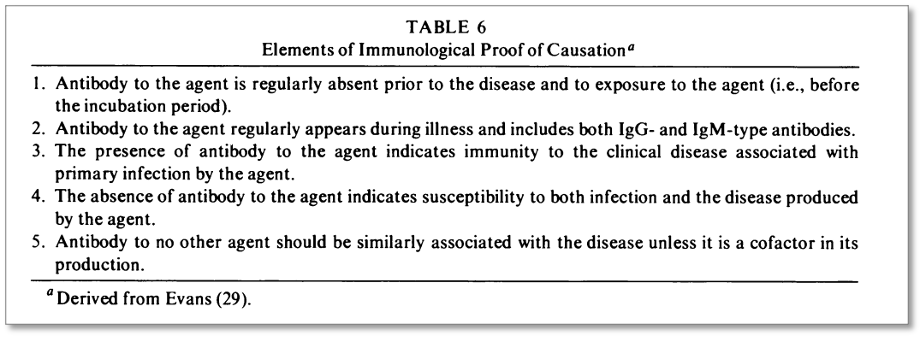
There are even more recent attempts to bring Koch-Henle postulates in line with modern day virology that now cannot, and should not, be separated from the genomic and bioinformatics tools that have thrown open the door to a much deeper understanding of living systems and their interaction with microbial communities.
Germ versus Terrain Theories
If you’re still reading this – well done! You’re around 4,500 words in and the journey I’ve taken you on brings us to what I feel is the most interesting place of all, because it’s where we can have a real win – for humanity, and for science and medicine.
It’s where we can get to with the interplay between two prevailing theories of disease that can be associated with infectious agents: the germ theory and the terrain theory, the latter often being attributed to the work of a contemporary of Pasteur, Antoine Béchamp.
Just as we recognise the limitations of the Koch-Henle postulates because of the historic era in which they were conceived, we must do the same with Béchamp. That means applying less of a focus on his microzymes and more on what makes up the genetic, physiological, immunological, metabolic and environmental terrain of the host and its surroundings. A big part of that includes the microbial communities associated with the host. It includes the pattern of gene expression of the host that is in turn a product of transgenerational inheritance and environment (i.e. epigenetics).
These are general concepts that Rivers and Evans were already beginning to grapple with, but they had yet to understand just how crucially important the microbial world was to the function of natural systems. Their minds were still tinged with a Pasteurian hew that made them think of microbes as, at best, commensal, but, more often, harmful. This notion was given a huge boost following Fleming’s discovery of penicillin in 1928 that spawned the advent of industrial scale pharmaceuticals in the Post-WWII era. The virus deniers rightly call out the harms that have been perpetrated on the public because of an excessive focus on germ theory to the exclusion of the individual’s terrain.
In 2020, I wrote a piece on ‘covid myopia’ that identified 52 risk factors for severe COVID-19 disease, the majority being modifiable. Following is a self-explanatory summary figure from the article.
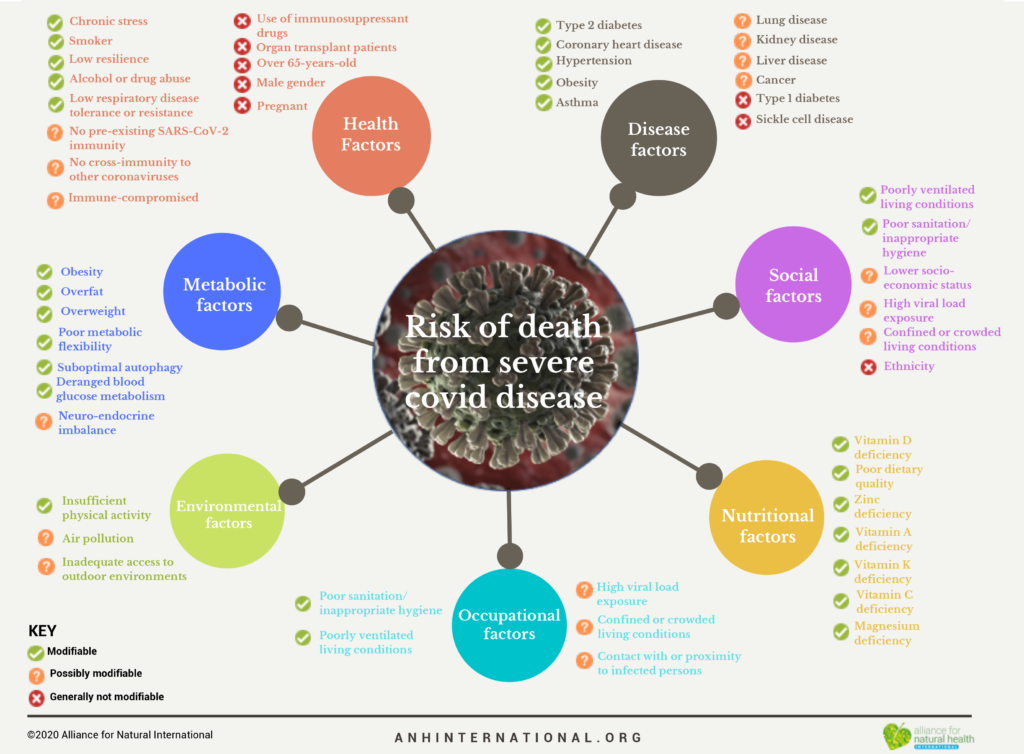
Health authorities, governments and even the majority in the medical profession were mute on most of these, such has been the political and economic drive to have us accept the latest patented weapons of germ warfare, new fangled, previously unproven ‘genetic vaccines’ and antivirals.
Without any robust evidence, these products were immediately mislabelled as “safe and effective” and marshalled on the world’s population, the producers being indemnified by governments in the event of any damages. It turns out, those who wanted to capitalise on the situation, one that was largely of their own making, knew there was no money to be made out of focusing on helping people to build more resilience into their physiology and terrain. They also undoubtedly knew that helping people build the resilience of their terrain would lessen their ability to control the masses — through mechanisms like social distancing, masking, mass surveillance, and mass vaccination.
Evolutionary and environmental ecology
Evolutionary biology is a fascinating discipline in itself but more relevant to our understanding of evolution and the role of viruses is an ecological perspective that is more commonly associated with evolutionary ecology.
We’re really beginning to understand that the progression of life on Earth is dependent on how living things interact as whole systems and interacting communities with both the living (biotic) and non-living (abiotic) world.
We’re learning that viruses likely preceded life on Earth and as evolutionary engineers were probably involved in helping it develop. In totality, viruses do way more good than harm – despite the relationship often being a bit messy early on when a virus discovers a new host. Living systems look to establish stability and they do this through developing complex interactions and feedback systems between the genes of living organisms and non-living things, including viruses, and their respective environments.
Technology, chemicals and radiation sources created by human beings have such profound impacts on both living and non-living systems, we must now factor these in so that we can manage interactions that don’t destroy the exquisite balance of life on our planet, and humanity itself.
Few recipients of Pfizer, Moderna or AstraZeneca’s C19 ‘genetic vaccines’ will likely have grappled with the notion that their body’s production of a patented protein, modelled on an engineered virus, sets them on the slippery slope towards transhumanism.
Epilogue
In this treatise, for what it’s worth, I’ve made my own views on the existence of viruses clear enough. I know it won’t be sufficient to convert a resolute virus denier, much in the same way a Flat Earther will have trouble convincing the others among us who have bought into the idea the earth is round – or at least roundish. But this article doesn’t aim to convert anyone. It simply provides a vehicle for free expression, a prerequisite for scientific discourse, and a call for us to focus on the things we can do when we are empowered and united on issues over which we share similar views.
I must also offer a word of caution: while those encouraging virus denial may be basking in the notion that they have just given the millions out there a good reason to say ‘no’ to genetic vaccines and antivirals about which they sense a problem, they should also contemplate the impact of a change of mind (or heart). A change that might occur if they struggle to take on board the idea that 100% of the morbidity and mortality that has been associated with COVID-19 over these last 3 years had nothing at all to do with any virus. What is the evidence of it being caused entirely by a catalogue of non-viral agents, from 5G, masks and stress, to bad diets, lack of physical activity and chemtrails? Try that one on for size given the available data.
The more we get diverted by sideline scuffles that divert our focus to irreconcilable differences in view, the less energy we get to apply to the gamut of areas over which our views are aligned. Also, the less likely we are to help co-create a future we might consider fit for future generations.
Let’s get this one put to bed sooner rather than later – and re-unite our movement based on the multitude of issues we do agree on. Let’s forge ahead with the extraordinarily ambitious task of re-building a world that respects and values humanity, human dignity and freedom, as well as nature. And one that tolerates and respects differences in opinion or perspective.
But let’s not forget for one minute Doug Altman and Mark Bland’s catch cry, ‘The absence of evidence is not evidence of absence.’
- Read Dr Meryl Nass’s Substack article asking Is the virus real?
- Original Article Click Here
- Here Dr Mark Trozzi discusses these same issues of Germ and Terrain theories, and questioning the existance of viruses and specifically SARS C0V2: https://drtrozzi.org/2022/09/05/germ-terrain-reality-is-sars-cov2-real/

